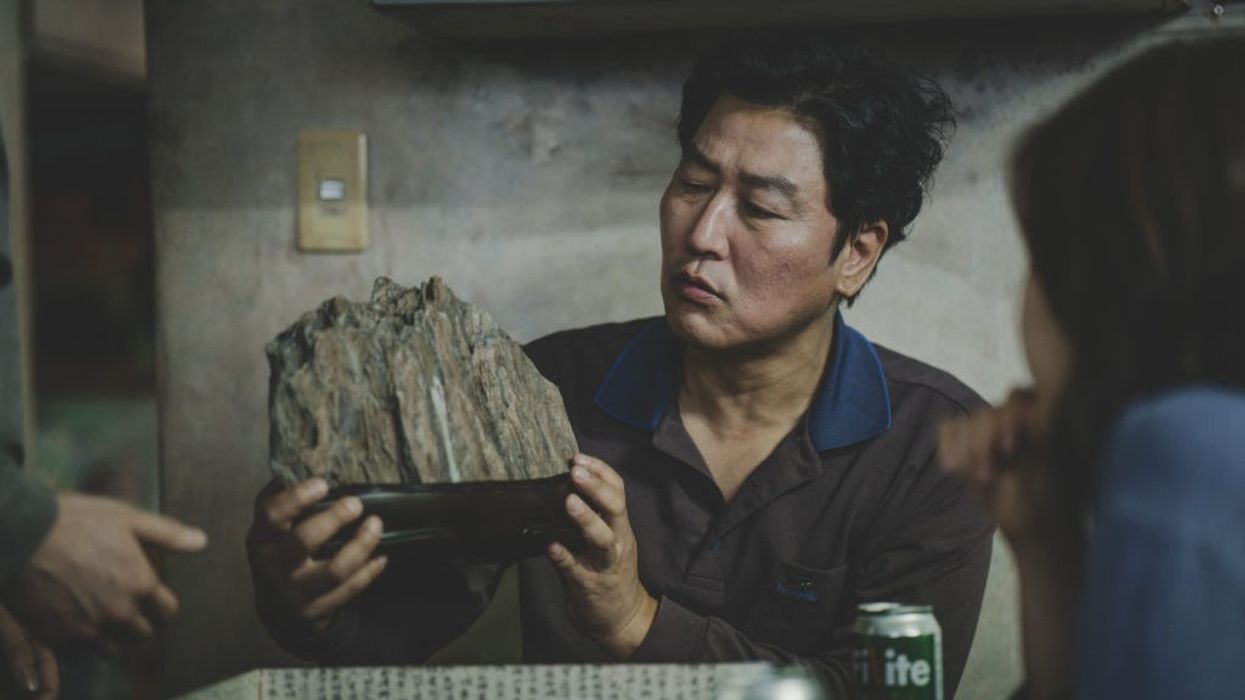What Are the Symbols in 'Parasite' and What Do They Mean?
Parasite is an incredibly deep social satire with expertly interwoven symbolism. So, how did director Bong Joon-ho do it?

As we deal with the rich having access to Covid-19 tests and tweeting out the music and lyrics of John Lennon from their palatial mansions while some of us plot to kill our roommates, I thought it was a great time to revisit Parasite.
While the news and the insane world seem to have slowed Parasite's press tour, there's no time like the present to dig into this masterpiece and talk about the symbolism at the core of its storytelling.
Check out the video from Lessons from the Screenplay and let's talk after the jump.
How are Symbols Used in Film?
Before we get into the nitty-gritty inside the movie, let's put down our peaches and talk about symbols. Symbols give you a way to sway the audience. They are tangible objects within the story that represent something larger than what they are.
They are objects bearing the weight of metaphor.
Sometimes we call these things "charged objects."
So, what are the 2 biggest symbols in Parasite according to the video?
- The viewing stone (also called the "scholar stone")
- The sense of smell
Let's start with the viewing stone.
The Viewing Stone
The viewing stone is a gift given to the Kims by their more successful friend. It symbolizes the life of prosperity they want to have. A future that seems out of their grasp given the current economic climate.
The family hopes the future is bright, and as they all start getting jobs working for a wealthy family, it is.
The hopes and dreams the stone symbolizes start to come to fruition.
The Sense of Smell
While not being as tangible as the stone, smell plays a huge role in the story.
We know all about how just the smell of peaches smell is a clear distinction between rich and poor. The mansion the Kims move into is clean and the thing they cook smell delicious, which is in direct opposition to their slum which smells like cheap food and people peeing outside.
There's also the way the Kims smell as opposed to their bosses. According to Ki-taek, all the Kims smell the same. They smell poor. They smell related, though he does not know that yet.
This sense of smell stays on them both literally and figuratively as the movie continues.
As the symbols repeat, you have to reclassify them as motifs.
What is a Motif?
The motif refers to the recurring thematic elements in a film. These elements must be repeated in a significant way or a way that conveys a purposeful pattern.
What are Parasite's motifs?
They are the symbols of the viewing stone and smell which become story tenements over and over.
The Viewing Stone as a Motif
Think about the viewing stone. It comes as a gift that pushes the Kims toward success. But as we see it throughout the story, it comes to represent the struggle. First, it's the dream of getting wealthy, but as the story goes on it becomes the dream of moving the entire family into the upper class.
When we see the drunk peeing outside, it's juxtaposed against the viewing stone.
When the Kims' basement home floods after almost getting caught staying at the Park's house, it's the viewing stone that floats to the surface...showing their sunken dreams.
"The Smell" as a Motif
An almost palpable sense of smell recurs over and over throughout Parasite. Sometimes it is implied, like when we see a toilet overflowing crap into the house in contrast to the stark and cleanly mansion. Sometimes it ties the rich and poor, like when expensive beef is added to the cheap ramen noodles, and the taste reminds the rich of the poor.
Other times, it's the stink the Kims cannot shake.
The one that lingers as their better life disappears.
This makes their smell haunt them...and bring everything back to the theme.
What is Theme?
The theme of your screenplay refers to the issue at the core of the story itself. This isn't mentioned in the script, but it's the emotional or spiritual driving force behind your movie's message. If you don't have a theme, then your mom will feel like it lacks purpose.
Think of the theme like the thesis statement of a paper.
John August describes the theme as "what is true and what is real."
So, what's true at the center of Parasite?
I think it's a question; an examination of who, exactly, is the parasite?
The theme is espoused in the ending of Parasite.
Bong Joon-ho shows that the lower classes are willing to kill one another over the limited space serving the top. When realistically, they outnumber their oppressors and could easily have all teamed up to kill the Park family and lived comfortably in the home together.
When asked by Slashfilm if he has an interpretation of the ending, he says, "That’s quite difficult to say, but I have my own thoughts on the ending. I’m always curious myself as I write a script whether it’s about the characters or the situations or the ending. I have several interpretations for the ending myself, but with this ending I just wanted to be honest. I didn’t want to create false hope and pretend to be hopeful. It’s sad but I wanted to show reality in a raw and unfiltered way."
So the net time you write, think about how symbols can affect your screenplay. Then, once you have those symbols, how they can inform the greater motifs at hand, as well as contribute to the theme!
What's next? Check out the Parasite script!
I'm still riding high on the best movie of the year winning four awards at the Oscars, but I wanted to take a beat to look at the screenplay for this wonderful film and explore five lessons young writers can take away from Bong Joon-Ho's process.
Keep reading!
Source: Lessons from the Screenplay














